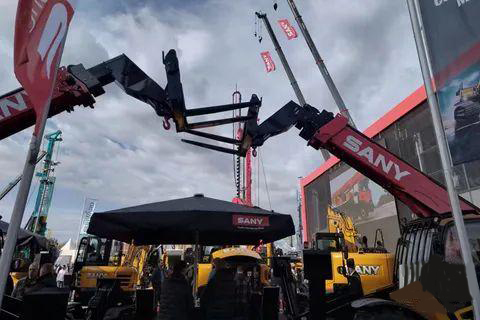


Due to the sharp rise in raw material costs and the shortage of parts and components, it is more difficult for the European and American machinery manufacturing industry chain to ship normally. If the export status of China's machinery industry to Europe and the United States continues for a longer period of time, the transfer trend of the industrial chain may become clear.

Different from the weak export in other fields, the export of China's machinery industry is still growing in an all-round way, and overseas orders are booming. "Exports are very good," said Lu Ying, deputy secretary-general of the China Construction Machinery Industry Association, to Caixin. According to the latest statistics from the China Construction Machinery Industry Association on 26 excavator manufacturers and 22 loader manufacturers, in September 2022, 10,667 excavators of various types were exported, with a year-on-year growth rate of 73.3%; 4,081 loaders of various types were exported. , an increase of 42.1% year-on-year. From January to September 2022, a total of 80,306 excavators of various types were exported, a year-on-year increase of 70.5%; 32,555 loaders of various types were exported, a year-on-year increase of 25.4%. This growth rate has continued the high growth trend since 2021: in that year, China exported a total of 68,427 excavators of various types, a year-on-year increase of 97%; and 34,008 loaders of various types, an increase of 38.2% year-on-year.
Lu Ying explained that due to the impact of the epidemic, machinery manufacturers in Europe and the United States are facing severe challenges. In the early stage, it was mainly due to the sharp rise in raw material costs and the shortage of parts and components. The difficulty in ensuring normal shipments in the European and American machinery manufacturing industry chains is increasing. The delivery cycle is prolonged, the supply speed is slowing down, and the market competitiveness is declining. This was exacerbated by high energy prices and a higher U.S. dollar index due to geopolitical conflicts. On the contrary, the complete industrial chain system of China's machinery manufacturing industry has shown resilience under the impact of the epidemic. Lu Ying introduced that China's reasonable layout, abundant production capacity and competitive prices have supported the sustained and rapid growth of China's machinery manufacturing exports. Steel is an important upstream industry of machinery manufacturing. China's steel supply and price advantages also provide unique advantages for the machinery manufacturing industry.
On the other hand, affected by the resurgence of the epidemic, the market demand of China's machinery manufacturing industry has been weak, and overseas orders have also made up for the lack of domestic market demand. "Our overseas orders have been scheduled until next year. Now we are not worried about orders, but more about shipping schedules and shipping." A related person from Sany Heavy Industry, a giant in the Chinese construction machinery field, told reporters. Supported by strong overseas demand, Sany Heavy Industry will double its sales revenue in more than 50 countries in 2021; from January to September 2022, it will realize international sales revenue of 25.88 billion yuan, a year-on-year increase of 43.7%; judging from the current orders, the international market It is expected to maintain a high growth trend.
At present, European factories cannot produce normally, and the industrial chain is difficult to guarantee normal shipments. Instead, imports from China make up for the gap. Lu Ying pointed out that although the export of China's machinery industry to Europe and the United States is expanding, it has not yet reached the level of industrial transfer; if the current economic situation continues for a longer period of time, the trend of industrial chain transfer may be more obvious. Interruption of the industrial chain "The impact of the epidemic on the industrial chain of the construction machinery industry is 'fatal'." Lu Ying said that the upstream and downstream of construction machinery are highly integrated, and any error in any link will lead to failure to ship normally. "Many pieces are produced It has come out, and it is almost installed, but there are still some parts that do not come, and this car will not leave the factory." At the same time, the industrial chain of the machinery manufacturing industry is long, and the cost of recovery once it is interrupted is very high. The restart of facilities, sales channels, etc. The re-maintenance of the government and service system, as well as the reconstruction of the professional industrial workforce, are facing many difficulties. So far, with rising energy prices and low demand, Europe has had to shut down a large number of high-energy-consuming industries to ensure a safe winter, and instead imports from China to meet some production and consumption needs, and the trade structure has turned into a deficit. According to the statistics of Tianfeng Securities, in the structure of changes in Germany's trade balance in the second quarter, the deficit of energy products was about 17.41 billion U.S. dollars, and the deficit of electrical equipment and mechanical equipment was about 5 billion U.S. dollars.
In Germany, the main production base of Liebherr, the global construction machinery manufacturing giant, according to the wholesale inflation data released by the German Federal Statistical Office in April 2022, the prices of metals and iron ore have risen sharply, rising by nearly 60% in the past year. Fuel oil rose by about 70%, and coal-based solid fuels rose by about 61% to a record. According to the latest data, Germany's inflation rate reached 10% in September, a record high, exceeding 7% for the seventh consecutive month since March 2022, of which energy prices rose by 43.9% year-on-year in the month. Another one of the world's largest construction machinery manufacturers, the "industrial bellwether" Caterpillar (NYSE: CAT), warned in its report for the second quarter of 2022 that global supply chain disruptions will continue, and higher costs and Weakness in the global economy will bring more risks to the industry. The company’s revenue in the second quarter was US$14.247 billion, an increase of 11% year-on-year, which was US$190 million lower than market expectations. The quarterly operating margin shrank to 13.6 percent from 13.9 percent a year earlier, amid a combination of falling sales and rising costs.
Chinese enterprises make efforts overseas
China's machinery manufacturing companies are actively deploying overseas markets, intending to increase their international market share. Sany Heavy Industry is a leading enterprise in China's construction machinery industry, mainly engaged in equipment manufacturing products such as excavation machinery, hoisting machinery, and concrete machinery. In the past two years, its excavation machinery has the highest market share in the world. As early as 2005, Sany established overseas factories and implemented a localized operation strategy. It has established four overseas R&D and manufacturing bases in India, the United States, Germany, and Brazil, and its business has covered more than 150 countries and regions around the world.
Since 2022, Sany has performed well in Indonesia, Latin America, Central Asia, the Middle East and other countries and regions. The announcement shows that from January to September, Sany achieved sales revenues of 11.595 billion, 7.517 billion, 4.846 billion, and 1.92 billion in Asia, Australia, Europe, America, and Africa, respectively, a year-on-year increase of 52.3%, 26.5%, 63.5%, and 29%. In addition, the operating performance of Chinese construction machinery giants such as Xugong Group and Zoomlion in overseas markets has also reached a new high. According to the financial report, Xugong Machinery (000425.SZ) achieved overseas sales revenue of 12.488 billion yuan in the first half of 2022, a year-on-year increase of 157.28%. During the period, the export revenue of Zoomlion (000157.SZ) increased by 40.45% year-on-year, and the sales performance of Indonesia, Saudi Arabia, the United Arab Emirates and other countries and regions that focused on promoting localization strategies increased by more than 100% year-on-year. "(2022) The entire company's emphasis on internationalization is significantly higher than in any previous year."
According to the aforementioned Sany Heavy Industry person, in order to increase the internationalization layout, the company plans to send more marketing and service personnel. In the next 2 to 3 years, it is expected that the international market will continue to rise. From a regional point of view, Sany Heavy Industry currently focuses on the Asia, Africa and Latin America regions, and plans to shift its focus to European and American markets with larger market capacity and higher demand in the next step. The person said that the current product quality, industrial layout, and research and development capabilities have all adapted to meet the needs of the European and American markets.
In order to revive the economy, many governments have vigorously stimulated investment in infrastructure construction, creating a lot of import demand for construction machinery products. In 2021, the United States will introduce a $1.2 trillion package of infrastructure bills for infrastructure facilities such as roads, railways, water conservancy, and car charging piles; the European Parliament approves a 30 billion-euro "connecting European facilities" plan, mainly for transportation, energy and digital infrastructure. As for Russia, which ranks first in terms of market capacity, as European and American brands withdraw or decrease, and Chinese brands continue to supply, there is also a large market space. According to public data, from January to July 2022, China's construction machinery exports to Africa and Latin America, the European Union, the United Kingdom, and the United States took the lead, accounting for 18.22%, 15.3%, and 10.75% respectively. The regional markets with larger growth rates mainly include Africa and Latin America, Russia and the United States, which are as high as 51.4%, 47.5% and 44.8% respectively.